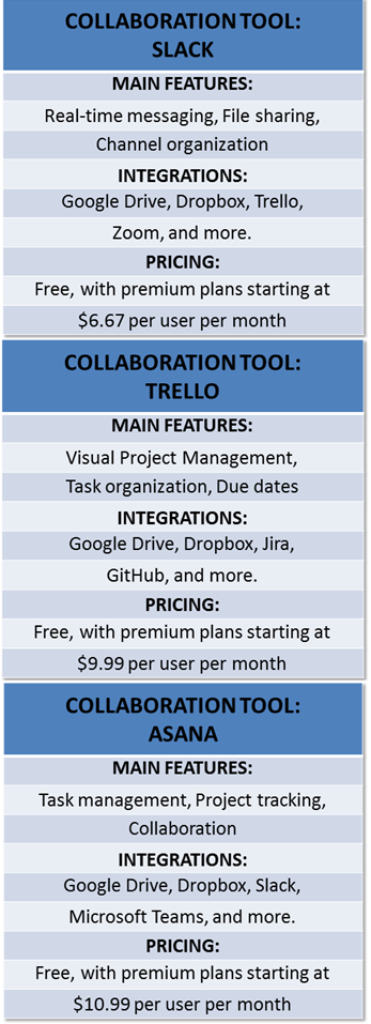In today’s business landscape, utilizing must-have digital tools is essential for success. By incorporating these tools into our workflow, we can enhance our efficiency, improve productivity, and streamline operations.
From mobile applications to collaboration tools, human resources management software, note-taking applications, and accounting tools, there are a variety of digital tools available to cater to our specific needs.
Key Takeaways:
- Digital tools play a crucial role in enhancing efficiency and productivity in business operations.
- Mobile applications enable seamless work and communication, especially for remote work scenarios.
- Collaboration tools foster teamwork, improve communication, and enhance overall efficiency.
- Human resources management software helps in enhancing employee performance and productivity.
- Note-taking applications contribute to organized and efficient work progress.
Mobile Applications for Seamless Work and Communication
The rise of remote work and the need for seamless communication have made mobile applications indispensable in today’s business environment.
In response these applications enable employees to work from home or any location outside the traditional office setting, while still staying connected and productive.
With the use of mobile apps, employees can access necessary software and tools, communicate with team members, and ensure efficiency, even when working remotely.
One of the key advantages of mobile applications is their ability to provide instant and constant communication.
The messaging functions integrated into these apps allow employees to send and receive real-time messages, exchange important information, and collaborate on projects.
This not only streamlines communication but also fosters teamwork and eliminates delays caused by waiting for responses via email or other means.
Moreover, mobile apps offer easy accessibility on smart devices, such as smartphones and tablets, which are widely used by employees.
This means that work can be done on the go, and employees can stay connected and productive even outside the office.
Whether it’s responding to emails, reviewing documents, or attending virtual meetings, mobile applications provide the necessary tools and functionalities for employees to carry out their tasks efficiently.

Benefits of Mobile Applications for Remote Work
- Flexibility: Employees can work from anywhere, at any time, providing a better work-life balance.
- Improved Collaboration: Mobile apps facilitate real-time communication and collaboration among team members.
- Increased Productivity: Instant access to necessary software and tools enhances productivity.
- Seamless Workflow: Mobile apps enable employees to continue their work seamlessly, regardless of their location.
- Cost Savings: With remote work, businesses can save on office space, utilities, and related expenses.
By leveraging mobile applications for remote work and seamless communication, businesses can adapt to the changing work landscape, and unlock new opportunities for growth and productivity.
The convenience, accessibility, and collaborative features provided by these apps empower employees to work efficiently and effectively, regardless of their physical location.
| Mobile Application | Key Features |
| Slack | Real-time messaging and file sharing. Integration with other tools and services. Channel-based communication for organized discussions Search functionality for easy retrieval of information |
| Microsoft Teams | Chat, video calls, and screen sharing, Collaboration on documents in real-time. Integration with Microsoft Office 365 Team and channel-based organization |
| Trello | Visual boards for task management, Collaboration, and assigning tasks to team members. Deadline tracking and progress monitoring, Integration with other productivity tools |
These are just a few examples of mobile applications that can greatly enhance work efficiency and communication in a remote work environment.
Through utilizing the right tools, businesses can empower their employees to work seamlessly, collaborate effectively, and achieve optimal productivity, regardless of their physical location.
Collaboration Tools to Foster Teamwork and Efficiency
Efficient collaboration is crucial for the success of any team. In the current digital era, collaboration tools have emerged as powerful solutions to improve teamwork, communication, and project management.
These tools provide a centralized platform where team members can connect, share files, exchange messages, and collaborate on tasks and projects.
Through the utilization of collaboration tools, teams can streamline their workflows, enhance efficiency, and achieve better outcomes.
One popular collaboration tool is Slack. With its user-friendly interface and robust features, Slack allows teams to communicate seamlessly in real-time.
Team members can create channels for different projects or topics, ensuring that relevant discussions and information are organized.
The messaging functions enable quick and efficient communication, eliminating the need for lengthy email chains.
Additionally, Slack integrates with numerous other apps and platforms, making it easy to share files, collaborate on documents, and even conduct video conferences.
Another powerful collaboration tool is Trello. This visual project management platform allows teams to create and organize tasks on a virtual board, making it easy to track progress and assign responsibilities.
Through the use of Trello, team members can collaborate by adding comments, attaching files, and setting due dates. The intuitive interface and customizable features make it a versatile tool for managing projects of any size.
By utilizing collaboration tools like Slack and Trello, teams can improve their communication, enhance teamwork, and increase overall efficiency.
These tools provide a centralized and organized space where team members can collaborate effectively, regardless of their physical location.
With real-time communication, seamless file sharing, and streamlined project management, collaboration tools empower teams to work together more efficiently and achieve their goals.

Table: Comparison of Popular Collaboration Tools

Note: The pricing mentioned in the table is subject to change. Please refer to the respective websites for the most up-to-date pricing information.
Human Resources Management Software for Enhanced Employee Performance
In today’s fast-paced business environment, optimizing employee productivity and performance is crucial for the success of any organization.
To achieve this goal, companies are increasingly turning to human resources management software (HRMS) as a powerful tool to streamline HR processes, improve communication, and enhance overall employee performance.
HRMS combines multiple functions like background information, performance analysis, recruitment, training, compensation, benefits, and payroll information into one centralized system.
This allows HR managers to access comprehensive employee data quickly and efficiently.
Highlighting the Benefits of HRMS
Implementing HRMS can have a significant impact on employee performance and productivity. Here are some key benefits:
- Efficient Training Needs Analysis: HRMS enables HR managers to identify skill gaps and training needs of employees. This, in turn, aids in designing targeted training programs to enhance employee competencies and performance.
- Improved Performance Evaluation: With the implementation of HRMS, managers can easily track and evaluate individual employee performance in real-time. This allows for timely feedback, recognition of achievements, and identification of areas for improvement.
- Streamlined Communication: HRMS facilitates seamless communication between HR departments, employees, and managers. By providing a platform for sharing important information, updates, and policies, ensuring that everyone is on the same page.
- Enhanced Employee Engagement: HRMS offers features like self-service portals, where employees can access their personal information, update records, and submit requests. This not only empowers employees but also fosters a sense of ownership and engagement.
Exploring the Key Features of HRMS
HRMS typically includes the following key features:
| Feature | Description |
| Employee Database | A centralized database to store and manage employee information, such as contact details, employment history, and performance records. |
| Performance Management | Tools to set performance goals, track progress, conduct performance appraisals, and provide feedback. |
| Training Management | Functionality to identify training needs, develop training programs, track participation, and evaluate the effectiveness of training initiatives. |
| Leave and Attendance Management | Automated systems to manage employee leave requests, track attendance, and generate reports. |
| Recruitment and Applicant Tracking | Tools to streamline the recruitment process, track applicants, and manage candidate data. |
| Compensation and Benefits Management | Functionality to manage employee compensation, benefits administration, and payroll processing. |
By leveraging the power of HRMS, companies can effectively manage their human resources, improve employee performance, and drive business success.
Note-Taking Applications for Organized and Efficient Work Progress
In today’s fast-paced business environment, staying organized and efficiently managing work progress is crucial for success. This is where note-taking applications come in handy.
These digital tools provide a user-friendly platform for capturing and organizing important information, allowing employees to stay focused, productive, and on top of their tasks.
Introducing one notable note-taking application, Evernote. With its intuitive interface and robust features, Evernote empowers users to take notes, create to-do lists, and store important documents in one centralized location.
Its search functionality enables quick retrieval of information, saving valuable time that would otherwise be wasted searching through stacks of paper or endless files.
With note-taking applications, you can easily jot down ideas, meeting minutes, action items, and any other important details during your workday.
These digital tools eliminate the need for physical notebooks, reducing clutter and ensuring that all your notes are conveniently accessible at any time and from any device.
This promotes a streamlined workflow, improves efficiency, and enhances collaboration within teams.

Benefits of Note-Taking Applications:
- Organized Work: Note-taking applications provide a structured approach to managing information, ensuring that nothing falls through the cracks. With features like tags, folders, and notebooks, you can categorize your notes and easily locate them when needed, keeping your work organized and efficient.
- Efficient Progress: By capturing important details in real-time and having them readily available, note-taking applications enable you to stay focused on your tasks and make progress without disruptions. You can also set reminders and deadlines, helping you stay on track and meet deadlines.
- Search Functionality: With powerful search functionality, note-taking applications allow you to find specific information within seconds.
- Whether you need to retrieve meeting minutes or refer back to an important idea, the search feature saves you time and eliminates the hassle of manual searching through stacks of notes.
By leveraging the capabilities of note-taking applications, you can optimize your work process, increase productivity, and ensure that no valuable information slips through the cracks.
So, embrace the digital era and implement these efficient tools to stay organized, streamline work progress, and achieve your professional goals.
| Note-Taking Application | Key Features |
| Evernote | Intuitive interface, robust search functionality, note organization, cross-platform availability. |
| Microsoft OneNote | Simplicity, real-time syncing, voice recording, and checklist creation. |
| Google Keep | Simplicity, real-time syncing, voice recording, checklist creation. |

Accounting Tools for Streamlined Financial Management
Efficient financial management is crucial for the success of any business.
By utilizing accounting tools, companies can streamline their financial processes, improve accuracy, and enhance overall efficiency.
These tools automate manual tasks, reduce errors, and provide valuable insights into the company’s financial health.
One example of an accounting tool is QuickBooks, a widely popular software that simplifies bookkeeping, invoicing, and tax preparation.
With its user-friendly interface and comprehensive features, QuickBooks enables businesses to manage their finances easily.
It allows users to track income and expenses, generate financial reports, and seamlessly integrate with other business systems.
Another powerful accounting tool is Sage, which offers advanced financial management capabilities.
Sage provides an array of features such as budgeting, forecasting, cash flow analysis, and inventory management.
It helps businesses make informed financial decisions and ensures compliance with accounting standards and regulations.
Highlighting the Benefits of Accounting Tools:
- Automated financial processes for increased efficiency
- Improved accuracy in financial calculations and reporting
- Streamlined invoicing and payment tracking
- Real-time access to financial data for informed decision-making
- Time-saving features that reduce manual work
| Accounting Tools | Features |
| QuickBooks | Bookkeeping, invoicing, tax preparation, financial reporting |
| Sage | Budgeting, forecasting, cash flow analysis, inventory management |
By incorporating accounting tools into their financial management processes, businesses can streamline their operations, save time, and ensure accurate financial reporting.
These tools provide a solid foundation for financial decision-making, enabling businesses to make informed choices that drive growth and success.
The Importance of Adopting New Technology for Small Businesses
In today’s fast-paced and highly competitive business landscape, small businesses must embrace new technology to stay relevant and thrive.
Adopting digital tools and leveraging the power of technology can greatly enhance productivity and drive business growth.
By harnessing the potential of innovative solutions, small businesses can level the playing field and compete with larger corporations.
One of the key benefits of adopting new technology is improved productivity.
Digital tools such as project management software, cloud-based collaboration platforms, and automated workflow systems can streamline operations, reduce manual tasks, and enable teams to work more efficiently.
With the right tools in place, small businesses can optimize their processes, eliminate bottlenecks, and achieve higher levels of productivity.
Furthermore, adopting new technology can directly contribute to business growth. By embracing digital solutions, small businesses can expand their reach, attract more customers, and compete on a global scale.
For example, e-commerce platforms, social media marketing tools, and online advertising platforms offer affordable and effective ways to reach a wider audience and increase sales.
With the right technology in place, small businesses can seize new opportunities, drive revenue growth, and achieve their long-term goals.

Moreover, embracing new technology is crucial for staying ahead of the competition.
In today’s digital era, customers expect businesses to be tech-savvy and offer seamless online experiences.
By adopting cutting-edge technology, small businesses can differentiate themselves from competitors and provide superior products or services.
Whether it’s implementing mobile payment solutions, using data analytics to gain insights into customer behavior, or integrating artificial intelligence to improve customer service, adopting new technology can give small businesses a competitive edge.
Table: Benefits of Adopting New Technology for Small Businesses
| Benefits | Description |
| Improved productivity | Streamlined operations, reduced manual tasks, and increased efficiency |
| Business growth | Expanded reach, increased customer base, and higher revenue |
| Competitive advantage | Differentiation from competitors, superior customer experiences |
Conclusion
Incorporating digital tools into our business is essential for enhancing efficiency, improving productivity, and streamlining operations.
With a wide range of options available, including mobile applications, collaboration tools, HRMS, note-taking applications, and accounting tools, we can make significant strides in our daily workflows.
By embracing these digital solutions, we can enhance communication among team members, foster teamwork, and improve overall employee performance.
The use of mobile applications allows for seamless work and communication, even when working remotely.
Collaboration tools like Slack provide a centralized platform for efficient team communication and project management.
Furthermore, human resources management software (HRMS) enables us to access employee information, identify training needs, and ultimately enhance productivity.
Note-taking applications like Evernote help us stay organized, access information quickly, and maximize our work progress.
Adopting accounting tools like QuickBooks and Sage streamline financial management, saving time and improving efficiency in the accounting and finance department.
By embracing new technology and utilizing these digital tools, we can achieve significant productivity gains, streamline our operations, and drive business growth.
Digital tools enhance our efficiency, improve our productivity, and ultimately contribute to the overall success of our business in today’s digital era.
FAQ
How can digital tools enhance efficiency in my business?
Digital tools help streamline operations, improve productivity, and enhance efficiency by automating tasks, facilitating communication and collaboration, and providing organized solutions for various business functions.
What role do mobile applications play in enhancing work productivity?
Mobile applications allow employees to work remotely, access necessary software and communicate with team members seamlessly.
They enable productivity even when away from the office and provide features like messaging functions and easy accessibility on mobile devices.
How can collaboration tools improve teamwork and efficiency?
Collaboration tools like Slack provide a centralized platform for team communication, file sharing, and project management.
They ensure everyone is on the same page, regardless of physical location, and enhance communication, teamwork, and efficiency in completing tasks and projects.
What benefits does Human Resources Management Software (HRMS) offer?
HRMS combines various functions like employee information, performance analysis, compensation, recruitment, and training.
It enables HR managers to access employee data, identify training needs, and improve overall productivity through regular evaluation of employee performance.
How can note-taking applications contribute to organized and efficient work?
Note-taking applications like Evernote provide a digital solution for capturing and organizing important details.
They allow employees to take notes, share ideas, and easily search for information using built-in search functionality.
This helps in staying organized, accessing information quickly, and improving overall work performance.
How do accounting tools streamline financial management?
Accounting tools like QuickBooks and Sage simplify financial tasks, automate processes, and handle a large volume of accounting tasks efficiently.
They enable accurate financial statement preparation, reduce manual work, and enhance efficiency in the accounting and finance departments.
Why is adopting new technology important for small businesses?
Adopting new technology allows small businesses to improve productivity, streamline operations, and enhance overall business growth.
It levels the playing field with larger corporations and provides opportunities for small businesses to compete effectively in the market.
How can digital tools enhance efficiency and productivity in my business?
By incorporating digital tools like mobile applications, collaboration tools, HRMS, note-taking applications, and accounting tools, businesses can enhance communication, foster teamwork, improve employee performance, and streamline workflows.
This leads to significant productivity gains, business growth, and a competitive edge in today’s digital era.


